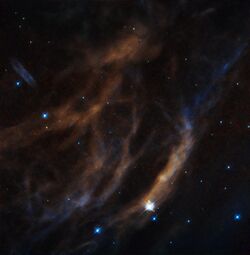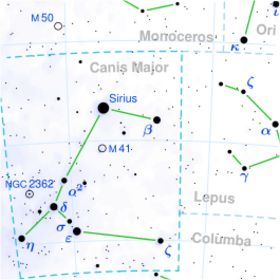Astronomy:EZ Canis Majoris
| Observation data Equinox J2000.0]] (ICRS) | |
|---|---|
| Constellation | Canis Major |
| Right ascension | 06h 54m 13.04410s[1] |
| Declination | −23° 55′ 42.0150″[1] |
| Apparent magnitude (V) | 6.91[2] 6.71 to 6.95[3] |
| Characteristics | |
| Spectral type | WN4-s[4] |
| U−B color index | −0.89[2] |
| B−V color index | −0.28[2] |
| Variable type | UGZ?[3] |
| Astrometry | |
| Proper motion (μ) | RA: −4.431±0.057[5] mas/yr Dec.: 2.884±0.092[5] mas/yr |
| Parallax (π) | 0.4119 ± 0.0503[5] mas |
| Distance | 4,900 ly (1,500[6] pc) |
| Absolute magnitude (MV) | −5.33[4] |
| Orbit[7] | |
| Period (P) | 3.63 d |
| Semi-major axis (a) | 0.13 au |
| Eccentricity (e) | 0.10 |
| Inclination (i) | 74° |
| Details | |
| WR | |
| Mass | 23[4] M☉ |
| Radius | 3.25[4] R☉ |
| Luminosity (bolometric) | 620,000[4] L☉ |
| Temperature | 89,100[4] K |
| companion | |
| Mass | 1.5[7] M☉ |
| Other designations | |
| Database references | |
| SIMBAD | data |
EZ Canis Majoris (abbreviated to EZ CMa, also designated as WR 6) is binary system in the constellation of Canis Major. The primary is a Wolf-Rayet star and it is one of the ten brightest Wolf-Rayet stars, brighter than apparent magnitude 7.[8]
Binary system

EZ CMa has an apparent visual magnitude which varies between 6.71 and 6.95 over a period of 3.766 days, along with changes in the spectrum.[9] It has been proposed that it could be a binary star, with a neutron star as companion that would complete an orbit around the Wolf-Rayet with that period, being the cause of those variations. The General Catalogue of Variable Stars lists it as a possible cataclysmic variable on this basis. It has been argued that the companion does not exist and spectral variations are caused by activity on the star's surface.[9]
Observations of the light variations over a four-month period from late 2015 to early 2016 confirmed the clear 3.76 d variations. This was interpreted as a 3.66 d orbital period with rapid apsidal precession completing a full rotation in about 100 days. The orbit is inclined at around 60–74 degrees and there are two eclipses during each orbit.[7]
Wolf Rayet star and nebula
The spectral type of WN4 indicates an extremely hot star, and this leads to a very high luminosity, mostly emitted as ultraviolet radiation. The spectrum shows a star entirely devoid of hydrogen at the surface.[4]
EZ CMa is surrounded by a faint bubble nebula, a small HII region blown by stellar winds up to 1,700 km/s and ionised by the intense UV radiation. This is catalogued as Sharpless Sh2-308, or just S308.[6] It is likely to be a member of the very scattered open cluster Collinder 121, found around the orange supergiant ο1 CMa.
References
- ↑ 1.0 1.1 Van Leeuwen, F. (2007). "Validation of the new Hipparcos reduction". Astronomy and Astrophysics 474 (2): 653–664. doi:10.1051/0004-6361:20078357. Bibcode: 2007A&A...474..653V.
- ↑ 2.0 2.1 2.2 Ducati, J. R. (2002). "VizieR Online Data Catalog: Catalogue of Stellar Photometry in Johnson's 11-color system". CDS/ADC Collection of Electronic Catalogues 2237: 0. Bibcode: 2002yCat.2237....0D.
- ↑ 3.0 3.1 Samus, N. N. et al. (2009). "VizieR Online Data Catalog: General Catalogue of Variable Stars (Samus+ 2007–2013)". VizieR On-line Data Catalog: B/GCVS. Originally Published in: 2009yCat....102025S 1: 02025. Bibcode: 2009yCat....102025S.
- ↑ 4.0 4.1 4.2 4.3 4.4 4.5 4.6 Sota, A.; Maíz Apellániz, J.; Morrell, N. I.; Barbá, R. H.; Walborn, N. R.; Gamen, R. C.; Arias, J. I.; Alfaro, E. J. et al. (2019). "The Galactic WN stars revisited. Impact of Gaia distances on fundamental stellar parameters". Astronomy & Astrophysics A57: 625. doi:10.1051/0004-6361/201834850. Bibcode: 2019A&A...625A..57H.
- ↑ 5.0 5.1 5.2 Brown, A. G. A. (August 2018). "Gaia Data Release 2: Summary of the contents and survey properties". Astronomy & Astrophysics 616: A1. doi:10.1051/0004-6361/201833051. Bibcode: 2018A&A...616A...1G. Gaia DR2 record for this source at VizieR.
- ↑ 6.0 6.1 Toalá, J. A.; Guerrero, M. A.; Ramos-Larios, G.; Guzmán, V. (2015). "WISE morphological study of Wolf-Rayet nebulae". Astronomy & Astrophysics 578: A66. doi:10.1051/0004-6361/201525706. ISSN 0004-6361. Bibcode: 2015A&A...578A..66T.
- ↑ 7.0 7.1 7.2 Schmutz, W.; Koenigsberger, G. (2019). "Long uninterrupted photometric observations of the Wolf-Rayet star EZ CMa by the Toronto BRITE satellite reveal a very fast apsidal motion". Astronomy & Astrophysics 624: L3. doi:10.1051/0004-6361/201935094. Bibcode: 2019A&A...624L...3S.
- ↑ Van Der Hucht, Karel A. (2001). "The VIIth catalogue of galactic Wolf–Rayet stars". New Astronomy Reviews 45 (3): 135–232. doi:10.1016/S1387-6473(00)00112-3. Bibcode: 2001NewAR..45..135V.
- ↑ 9.0 9.1 St-Louis, Nicole; Dalton, M. J.; Marchenko, S. V.; Moffat, A. F. J.; Willis, A. J. (1995). "The [ITAL]IUE[/ITAL] Mega Campaign: Wind Structure and Variability of HD 50896 (WN5)". The Astrophysical Journal 452. doi:10.1086/309706. Bibcode: 1995ApJ...452L..57S.
- ↑ "MAST: Barbara A. Mikulski Archive for Space Telescopes". Space Telescope Science Institute. https://mast.stsci.edu/portal/Mashup/Clients/Mast/Portal.html.
External links
- NASA Astronomy Picture of the Day: Sharpless 308 (23 April 2009)
- NASA Astronomy Picture of the Day: Sharpless 308: Star Bubble (23 June 2015)
 |



